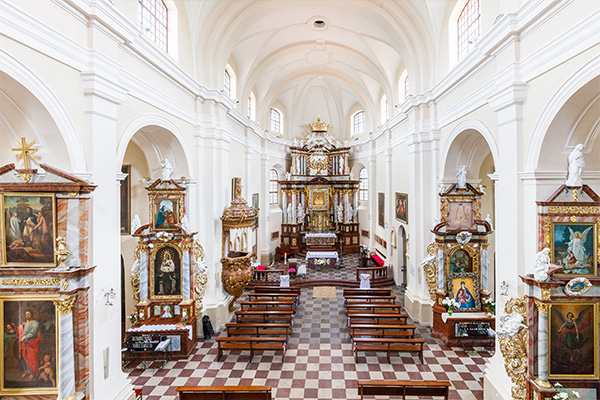This Church is included as part of the following itinerary: The Route of Saint John Paul II, Places of Marian Devotion.
St. John Paul II possessed a special devotion to the Mother of God. As his apostolic motto, he chose “Totus Tuus” (“Totally Thine”), a proclamation of love and faithfulness to the Holy Virgin Mary. Trakai Church of the Visitation of the Blessed Virgin Mary is a testament to the deep Lithuanian tradition of devotion to Mary. The altar is adorned by the image of the Mother of God – Patron of Lithuania and is renowned for its special graces. It was the first image of Mary in Lithuania to be crowned by the pope, and it received the title of the Intercessor of the Afflicted on September 4, 1718.
The Church was built in 1409 due to the initiative of the Lithuanian Grand Duke Vytautas and was granted the title of the Visitation of Elizabeth by the Blessed Virgin Mary. In Christian tradition, this event is perceived as an encounter between the old and the new covenant. The interior Church walls, dated to the 15th century, are adorned with Byzantine-style painting, with the first fragments of it discovered in 2006. The frescoes depict scenes from the Old and New Testament. This Church has an enduring reverence for the Rosary. For that reason, the altar of the Virgin Mary in the Church’s northeast corner displays the 17th-century painting of “Our Lady of the Rosary with St. Dominic and St. Catherine of Siena”. This Church has never been closed, given to another religious denomination, or used for other purposes. Consequently, Trakai Church is an exceptional monument to faith and Lithuanian culture, representing an ecclesiastical and artistic legacy of six centuries.
The Church features a Byzantine-style painting depicting the Mother of God Hodegetria (from Greek: “She who shows the Way”). In it, Child Jesus is wearing a purple tunic and is seated on Mary’s left knee. He’s holding a book in His left hand while reaching His right hand towards three roses held by His Mother, which represent three Mysteries of the Rosary. The Mother of God painting of Trakai is closely associated with the Grand Duke Vytautas. The 17th-century inscription on the back of the painting provides that it was given to Vytautas as a baptismal gift by the Byzantine Emperor Emanuel II Paleologos. Over the years it had served as a reminder of the majestic rule of Vytautas. This image of Mary strengthened the nation, and for that reason, it became a destination for prayer to supreme state rulers, nobles, and people from all over the region.
Monday–Sunday – 9 a.m.–7 p.m.
Monday–Saturday – 6 p.m.
Sunday – 12 p.m.(noon)
Monday–Saturday – 5 p.m.
Sunday– 10 a.m.
The Assumption of the Blessed Virgin Mary – 15th of August
The Birth of Our Lady (Trakinės) – from 2nd –till 8th of September





